#daniel perry verdict
Explore tagged Tumblr posts
Text
William Melhado at The Texas Tribune:
More than a year after a Travis County jury convicted Daniel Perry of murdering a protester in Austin, Gov. Greg Abbott pardoned Perry, 37, on Thursday shortly after the Texas Board of Pardons and Paroles recommended a full pardon.
A Texas state district court judge sentenced Perry in May 2023 to 25 years in prison for shooting and killing U.S. Air Force veteran Garrett Foster during a 2020 demonstration protesting police brutality against people of color. One day after a jury convicted Perry, Abbott directed the parole board to review the former U.S. Army sergeant’s case. “Among the voluminous files reviewed by the Board, they considered information provided by the Travis County District Attorney, the full investigative report on Daniel Perry, plus a review of all the testimony provided at trial,” Abbott said in a statement announcing the proclamation that absolved Perry. “Texas has one of the strongest ‘Stand Your Ground’ laws of self-defense that cannot be nullified by a jury or a progressive District Attorney.���
Abbott approved the board’s recommendation, which included restoration of Perry’s firearm rights. Whitney Mitchell, Foster's common-law wife, said that she had expected to grow old with Foster before Perry murdered him. In a Thursday statement, she said Abbott's pardon made Texans less safe. “Daniel Perry texted his friends about plans to murder a protester he disagreed with. After a lengthy trial, with an abundance of evidence, 12 impartial Texans determined that he carried out that plan, and murdered my Garrett,” Mitchell said. “With this pardon, the Governor has desecrated the life of a murdered Texan and US Air Force veteran, and impugned that jury’s just verdict. He has declared that Texans who hold political views that are different from his — and different from those in power — can be killed in this State with impunity.”
[...] Perry was driving for Uber at the time he encountered protesters a few blocks from the Capitol in downtown Austin. He stopped his car and honked at protesters as they walked through the street. Seconds later, he drove his car into the crowd, Austin police said. Foster was openly carrying an AK-47 rifle at the time and during the trial, each side presented conflicting accounts as to whether the protester raised the gun to Perry who was also legally armed. Perry shot Foster and then fled the area, police said. He then called police and reported what happened, claiming he shot in self-defense after Foster aimed his weapon at him.
[...] Abbott rarely issues pardons, which the board must recommend before the governor can act. Abbott granted three pardons in 2023, two pardons in 2022 and eight in 2021 — most for lower-level offenses. Shortly after Perry’s conviction, unsealed court documents revealed he had made a slew of racist, threatening comments about protesters in text messages and social media posts. Days after George Floyd’s murder by a Minneapolis police officer prompted nationwide protests, Perry sent a text message saying, “I might go to Dallas to shoot looters.” Both Perry and Foster are white. Perry, a U.S. Army sergeant, also sent racist and anti-Muslim messages before and after Floyd’s death. In April 2020, he sent a meme, which included a photo of a woman holding her child’s head under water in the bath, with the text, “WHEN YOUR DAUGHTERS FIRST CRUSH IS A LITTLE NEGRO BOY,” according to the state’s filing.
Texas Gov. Greg Abbott (R) made a politically-motivated pardon of racist murderer Daniel Perry, who killed Garrett Wolfe at a 2020 Black Lives Matter protest.
See Also:
The Guardian: Texas governor pardons man who killed Black Lives Matter protester in 2020
#Greg Abbott#Daniel Perry#Black Lives Matter Protests#Texas#Pardons#Garrett Foster#Black Lives Matter
16 notes
·
View notes
Text
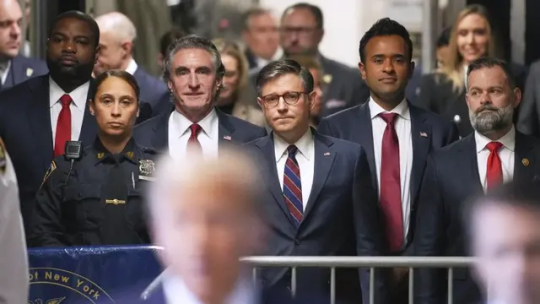
Trump sycophants parroting attacks on justice system risk further provoking MAGA extremists
+
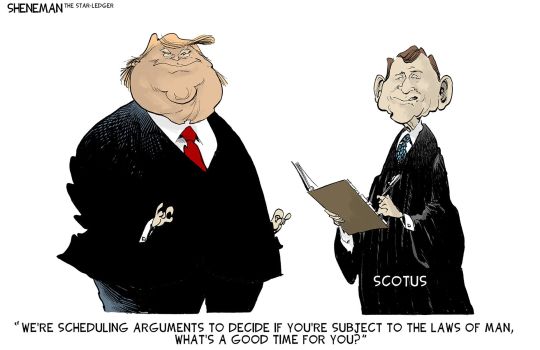
+
Defending the Judiciary in 2024
May 17, 2024
ROBERT B. HUBBELL
Events on Thursday highlighted yet another reason Democrats must vote in record numbers in November to defeat MAGA extremism. Republicans are undermining the institution of the judiciary in every way imaginable. Eroding the legitimacy and authority of the courts is textbook fascism. Indeed, in fascist states, courts are co-opted or replaced, becoming instruments of totalitarian rule.
Every American should be concerned about the coordinated assault on the judiciary by MAGA extremists.
It is difficult to identify Thursday’s most egregious attack on the legitimacy of the courts, but it seems appropriate to begin with Justice Samuel Alito.
Justice Alito displays a “Stop the Steal” flag on his front lawn.
As a Supreme Court justice, Alito has been unapologetic in his efforts to defend Trump's lawlessness. He has risen to Trump's defense with gleeful spite and unveiled resentment against those seeking to hold Trump accountable under the Constitution.
On Thursday, the New York Times revealed that Alito’s home displayed an upside-down US flag during the fraught days after the January 6 insurrection. At the time, flying the US flag upside down was a symbol calling to “Stop the Steal” of the 2020 election from Trump. It was a call to insurrection—proudly displayed by a US Supreme Court justice sworn to defend and protect the Constitution. See New York Times, At Justice Alito’s House, a ‘Stop the Steal’ Symbol on Display. (This article is accessible to all.)
In response to an inquiry from the Times, Alito said,
I had no involvement whatsoever in the flying of the flag.
Notably, Alito did not deny the veracity of the photograph of the flag flying upside down on his lawn. He did not deny the symbolism of the upside-down flag. He did not deny that he was aware of its continued presence in front of his house. Instead, he blamed his wife, whom he claimed flew the “Stop the Steal” banner in response to anti-Trump signs in the neighborhood.
Alito’s response to the Times is a lie. He owns the flag. He owns the flagpole. He owns the property on which the flag was displayed. He permitted it to remain on display on his property. He, therefore, did have “involvement” in “flying the flag.” It does not matter that it was his wife who physically raised the “Stop the Steal” banner on the flagpole. Alito’s hair-splitting denial is misleading and incomplete—and therefore false.
All of this leaves us with a second justice on the Supreme Court whose spouse was a booster of the effort to overthrow the Constitution and prevent the peaceful transfer of power.
Those justices—Alito and Thomas—are currently considering Trump's presidential immunity defense to the indictment alleging that Trump attempted to subvert the election. Under any reasonable reading of Code of Conduct that applies to Supreme Court justices, Alito and Thomas should have recused themselves long ago (under Canons 2 and 3).
The fact that Alito and Thomas have failed to do so is an open wound on the Court, oozing pus and bile every time they take the bench in a matter involving Trump's coup and insurrection.
Ultimately, the feckless Chief Justice John Roberts is to blame. He has allowed a sprawling and continuing scandal to consume the dwindling legitimacy of the Court. He has allowed that scandal to fester in order to provide cover for the most corrupt president in our nation’s history—which is a fitting epitaph for Roberts’ squandered legacy.
Texas Governor Abbott nullifies jury’s conviction of racist who killed Black Lives Matter protestor.
In the aftermath of the murder of George Floyd, Daniel Perry shot and killed a protester who was carrying a gun (which is legal in Texas). A jury heard the evidence—including Perry’s claim of self-defense—and convicted Perry of murder. Perry was sentenced to 25 years in prison. After the verdict, Texas Governor Greg Abbott said he wanted to pardon Perry.
On Thursday, the Texas pardon board gave Abbott the recommendation to pardon Perry. Abbott issued an immediate pardon, and Perry is now back on the street—with his right to carry firearms restored. See Texas Gov. Greg Abbott pardons Daniel Perry, Army sergeant convicted of murdering protester in 2020 (nbcnews.com).
In pardoning Perry, Abbott issued a statement that denigrated the jury’s verdict and consideration of the evidence of self-defense. Abbott wrote,
Texas has one of the strongest ‘Stand Your Ground’ laws of self-defense that cannot be nullified by a jury . . . .
When a jury hears the evidence and concludes “beyond a reasonable doubt” that the defendant is guilty, notwithstanding claimed self-defense, that verdict is not a “nullification” of the law; it is the application of the law. But in Abbot’s MAGA extremist administration, jury verdicts that run contrary to MAGA orthodoxy can be disregarded.
Overriding the justice system to advance partisan political ends is dangerous. If some Texans believe that the law does not apply to them, they will act lawlessly—exactly as Daniel Perry did when he shot a protester who was trying to make the point that Black lives matter to the same degree as white lives. Today, Governor Greg Abbott told Texans that is not true in Texas—and he did so by attacking the integrity of the jury trial system. The message and the means are antithetical to democracy.
New parade of GOP representatives appears at Trump trial
The “red tie” brigade was back in force at the Trump trial in Manhattan. About a dozen Republicans (mostly from Congress) appeared outside the courtroom to bash Judge Merchan, his family, and prosecutors. They filed into the courtroom as a phalanx, interrupting the cross-examination of Michael Cohen.
Why was Thursday’s spectacle worse than those on previous days? Because those who rose to show their support for Trump included Trump's indicted co-conspirator, Jeffrey Clark, as well as outcasts of the Freedom Caucus Lauren Boebert and Matt Gaetz.
In a particularly appalling statement, Gaetz posted a picture of Thursday’s parade of GOP officials at the trial alongside the caption, “Standing back and standing by, Mr. President.”
To be clear, Gaetz’s statement is a threat of violence against the judiciary if Trump is convicted. There is no other reasonable interpretation of the picture and caption in the context of the statements made outside the courtroom. See HuffPo, Matt Gaetz Parrots Trump’s Call To Proud Boys At His Trial.
The continued spectacle by Republican lawmakers is a clear violation of the gag order. The government officials are escorted into the courtroom and seated in seats reserved for Trump's defense team. As visible members of Trump's defense team, their statements are made on behalf of Trump. Judge Merchan should find Trump in contempt for those statements and order Trump to be detained. The failure of Judge Merchan to do so further undermines the authority of the judicial system.
While I am not criticizing Judge Merchan, it is clear that the willingness of Republican officials to break every norm of the rule of law has overwhelmed the ability of the judge to enforce the rules against Trump. And with the overlay of Gaetz’s threat of violence, Judge Merchan’s reluctance to apply the rule of law to Trump is understandable—though disappointing.
Here's my point: Thursday brought to the fore multiple examples of the MAGA effort to undermine the judiciary in the US. The only way to stop the attacks is to defeat Republicans up and down the ballot. The 2024 election is important for many reasons, not merely because we will re-elect Joe Biden. We must reverse the retrograde, reactionary MAGA movement to destroy one of the most important guardrails in democracy—a fair and independent judiciary.
Justice Alito dissents in case that would have triggered a Great Depression
On Thursday, the Supreme Court upheld the Consumer Financial Protection Bureau (CFPB). In so holding, seven justices rejected a theory that would have declared two-thirds of federal funding unconstitutional and eliminated regulations that control the banking and financial markets. The banking industry was so alarmed that it begged the justices to save the CFPB and the regulations that instruct the industry on how to conduct business lawfully. See Ian Millhiser in Vox, The Supreme Court decides not to trigger a second Great Depression.
The case is notable because it represents another defeat for the rogue judges on the reactionary Fifth Circuit who are hellbent on destroying the federal system of regulation that is responsible for the orderly operation of the world’s largest economy. See Mark Joseph Stern in Slate, Supreme Court CFPB: The judicial arsonists went too far for the conservative justices this time.
But justices Alito and Gorsuch dissented, arguing that Congress must continually re-authorize and fund federal programs that are permanent fixtures of the American system of regulation. As Mark Joseph Stern notes, Alito cited to English history under King James to bolster his contention that the Supreme Court can strike down congressional appropriations:
To side with the 5th Circuit, Alito had to fixate on a somewhat random period of English history in the 17th century—from James I to Charles I—to assert that the Constitution empowers courts to strike down appropriations that they dislike.
Alito and Gorsuch are dangerous radicals whose voices must be overwhelmed by expanding the Court.
[Robert B. Hubbell Newsletter]
#Robert B. Hubbell#Robert B Hubbell Newsletter#Corrupt SCOTUS#rule of law#corruption#Gov Abbott#Alito#Gorsuch#5th Circuit#US Judiciary#expand the court#Sheneman#political cartoons
2 notes
·
View notes
Text
Whitney Mitchell, Foster's common-law wife, said that she had expected to grow old with Foster before Perry murdered him. In a Thursday statement, she said Abbott's pardon made Texans less safe. “Daniel Perry texted his friends about plans to murder a protester he disagreed with. After a lengthy trial, with an abundance of evidence, 12 impartial Texans determined that he carried out that plan, and murdered my Garrett,” Mitchell said. “With this pardon, the Governor has desecrated the life of a murdered Texan and US Air Force veteran, and impugned that jury’s just verdict. He has declared that Texans who hold political views that are different from his — and different from those in power — can be killed in this State with impunity.”
...Doug O'Connell, Perry's lawyer, thanked Abbott on Thursday for pardoning his client. He also thanked the board for investigating what he said was an illegal threat by Foster, that led to the incident on Congress Avenue in Austin. “Daniel Perry was imprisoned for 372 days and lost the military career that he loved,” O'Connell said in a statement. “We intend to fight to get Daniel's military service characterization upgraded to an Honorable Discharge.” ...Perry was driving for Uber at the time he encountered protesters a few blocks from the Capitol in downtown Austin. He stopped his car and honked at protesters as they walked through the street. Seconds later, he drove his car into the crowd, Austin police said.
Law and order for thee, not for me.
Systemic killing and brutality are features, not bugs, of the American state. Praise be to those who defend the ability of governments, corporations, and police to murder with abandon, and death to those who oppose it.
The truth is that no state can function without this kind of violence. The American state's minor variation on it is that it outsources much of the brutality and open homicide to the private sector, which operates with more opacity and can justify itself with the profit motive. Mass exploitation of workers and customers is not the result of a broken system, but the means by which the state system is maintained.
To claim that America's systems are "broken" implies that there are versions of these systems that are sound. This is a misdirection. You can examine any country that has universal healthcare and note extreme inequality, worker exploitation, police violence, state-sanctioned killings and imprisonments, and deep-rooted racism, misogyny, and queerphobia in each of them. Every single state is built on a foundation of violence and inequality.
Take France, for example, which has been plagued by a loathsome president for years now. Macron, a banker, took power, added his cronies to government posts, and, among other things, let his security director beat people up wherever he went, raised the retirement age against militant protests, and cozied up to far-right extremists in government. In fact, the Parliamentary elections he called a few months ago resulted in a majority for the left-wing party that stood in opposition to Le Pen's cabal of Neo-Nazi goons. Macron decided that rather than let the winners of the popular vote govern, he would work with Le Pen to create a minority governing coalition instead, further legitimizing an apologist for her Neo-Nazi father.
The end result is not universal healthcare. Healthcare is just one of many steps we need to take to break the chains the government shackles us with and the yokes that corporations have on our necks.
The ruling class is not terrified that we might rally to fight for stronger labor rights (which France has), for universal healthcare (again, a French standard), a shorter work week or universal basic income (piloted by "nanny state" Finland). These are all social realities that states can survive with, especially insofar as they serve to legitimize the state's power over the many.
No, what the ruling class fears is that the murder of this single CEO may so galvanize an American public that has so frequently over the past decades shown itself to be utterly fed up with its rulers that they will protest, vote against their interests, and rally behind folk heroes that that public realizes that the difference among them are far less stark than the differences between them and their rulers both political and corporate that they will challenge the very foundation on which the system rests.
The risk that the United Healthcare CEO shooter poses to the American ruling class is that the people they brutalize will realize their own capacity for transformative violence, recognize that their elected officials and corporate owners are the sources of their suffering, and use their own power to overthrow the very system, the state, itself.
The shooter threatened the entire system with the prospect that we may figgt for our own happiness and futures.
But the state trafficks in our misery.
Rest assured, they will find a way to co-opt the shooter, to transform him and his ideals into something they can package and sell. Unpersoning him will do no good, and it's a stopgap until they can find the angle that will make us all submit once more to the crushing reality that we are not free, that we are grist for their mill, and that they get to decide what we do with our lives and our deaths, not us.
Unless we keep fighting.
0 notes
Text
The Case of the Autographed Corpse
https://sciencespies.com/history/the-case-of-the-autographed-corpse/
The Case of the Autographed Corpse
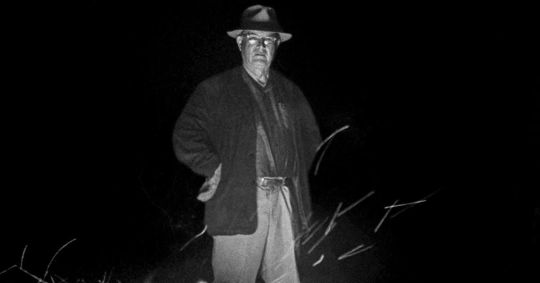
On a Saturday afternoon in February 1933, at the Fort Apache Reservation in Arizona, a White Mountain Apache Indian named Silas John Edwards and his wife, Margaret, stopped by a friend’s place to visit and relax. Edwards, a trim middle-aged man with a penetrating gaze, was an influential figure on reservations throughout the Southwest. Hundreds of followers regarded him as a divinely inspired religious leader, a renowned shaman and medicine man.
When he and Margaret arrived at their friend’s dwelling, a tepee, they found people drinking tulapai, a homemade Apache liquor. Three hours later, the Edwardses joined a group heading to another friend’s home. People who were there reported that Margaret confronted him inside a tepee, demanding to know why he’d been spending time with a younger woman, one of Margaret’s relatives. The argument escalated, and Margaret threatened to end their marriage. She left the party. Edwards stayed until about 10:30 p.m. and then spent the night at a friend’s.
Shocking news came the next day: Margaret was dead. Children had discovered her body, along with bloody rocks, at the side of a trail two and a half miles outside of the Fort Apache town of Whiteriver. They alerted adults, who carried her body home. “I went in the tepee and found my wife in my own bed,” Edwards later wrote. “I went to her bedside and before I fully realized what I was doing or that she was really dead, I had picked her up in my arms, her head was very bloody and a part of the blood got on my hands and clothing.”
He was still kneeling there, holding his wife’s body, when a sheriff and an Apache police officer arrived. The reservation was patrolled largely by Indian officers, but ever since the Major Crimes Act of 1885, certain crimes on Indian reservations had fallen under federal jurisdiction. Murder was one of them.
A medical examiner reported that Margaret had been killed by blows to her head and strangulation. Curiously, at least two of the rocks used to crush her skull were inscribed with her husband’s initials: S.J.E.
The rocks were key pieces of evidence when Edwards stood trial in federal court in October of that year. The 12 white men on the jury delivered a guilty verdict and the judge sentenced Edwards to life in prison. He was sent to McNeil Island Federal Penitentiary in Steilacoom, Washington.
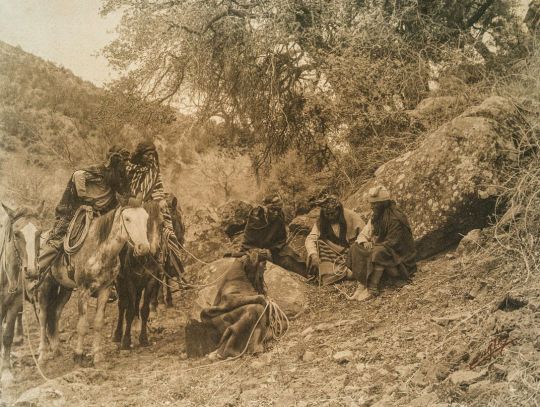
White Mountain Apaches gather for storytelling in 1904. The group is one of five related Western Apache bands whose hunter-gatherer ancestors are thought to have migrated to the region that is now Arizona from Yukon or Alaska.
(Alamy)
Seventeen years later, in March 1951, Edwards—now 64 and still imprisoned at McNeil Island—wrote a desperate letter. “Up ’til now you have never heard of me,” he began, and then repeated the protestations of innocence he’d been making ever since his arrest. He had affidavits from witnesses who’d said he could not have committed the murder. The White Mountain Apache Tribal Council had unanimously recommended his release from prison. Another suspect had even been found. Edwards had pleaded with authorities for a pardon or parole, but nothing he did could move them.
This letter was a last-ditch effort to avoid dying of old age behind bars. Edwards thought the man he was writing to could get him out. The man was Erle Stanley Gardner, the author of the Perry Mason mystery books.
At the time, Gardner was America’s best-selling author. He was also a lawyer, and soon after he received Edwards’ letter, he agreed to help. Thus began an unprecedented partnership between an imprisoned Apache holy man and a fiction writer who’d made the dramatization of crime a national obsession.
* * *
Until the day of Margaret’s murder, Edwards had spent his whole life on Indian reservations. His grandparents had been born in the same region when it was still part of Mexico. They’d lived in family groups that grew corn, beans and squash along waterways nearby.
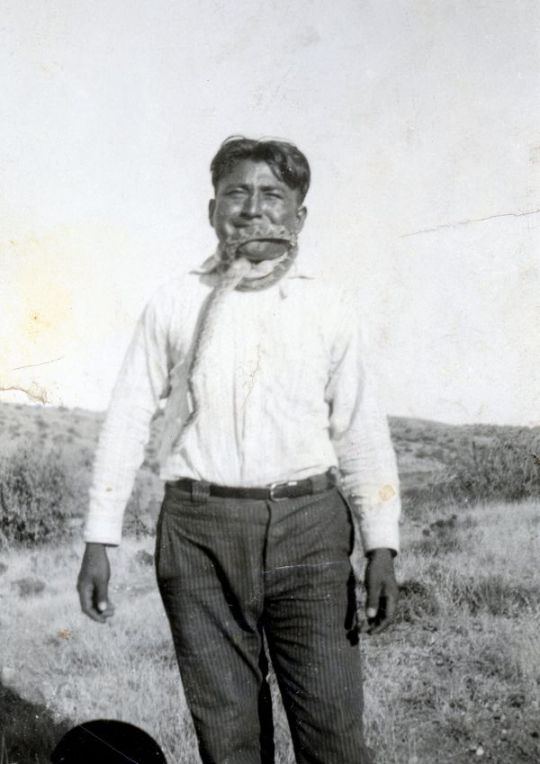
Silas John Edwards, who learned from his father how to treat illnesses by tapping the power of rattlesnakes, in an undated photo.
(Edgar Guenther courtesy William Kessel)
His parents, born after the Mexican-American War in the recently annexed New Mexico Territory, spent their lives worrying about the increasingly hostile U.S. Army, which built a garrison at Fort Apache on the White Mountain tribe’s land. The Indians could no longer travel, trade or even raise crops freely.
Nonetheless, a group of 50 White Mountain Apache men helped the U.S. defeat Geronimo in 1886. As a reward, the U.S. government allowed them to continue living on part of their ancestral territory, establishing the White Mountain Reservation (divided into the Fort Apache and San Carlos reservations). The reservation was a gorgeous expanse of mountains and valleys. Edwards was born there in the 1880s and given the name Pay-yay.
As a child, he was raised with traditional beliefs about male, female and animal deities who had created the world and given power and good fortune to the Apache people. But life on the Apache reservations was hard. Government food rations were insufficient. Starting in the 1890s, Indian children were required to attend schools where they had to shed cultural practices, from hairstyle to language. Edwards and his classmates were given Anglicized names.
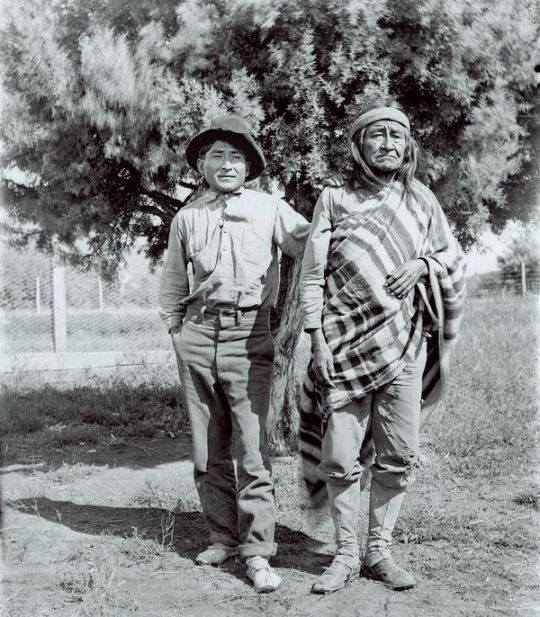
Silas John Edwards (left) and his father, photographed by the Rev. E. Edgar Guenther, who submitted this picture to a contest under the title “The Old and the New.” He was awarded a $10 prize for it.
(Edgar Guenther courtesy William Kessel)
But their geographic isolation allowed the White Mountain Apaches to keep some of their traditions. Edwards learned from his father, a medicine man, how to treat illnesses by tapping into the power of rattlesnakes. He also became skilled at tanning rattlesnake skins, and crafting hatbands and other goods from them. Blue dots tattooed along the bridge of his nose and on his chin soon signified his special talents as a practitioner of traditional Apache medicine.
In 1911, a young Lutheran missionary named Edgar Guenther arrived at the reservation. He and his wife, Minnie, would remain in the area for 50 years. Under the pastor’s tutelage, Edwards converted to Christianity and began working as an interpreter for church services. He was especially fascinated by a biblical passage, Numbers 21:4-9, that described God setting venomous snakes on the rebellious Israelites. He and the minister had a falling out after Guenther discovered that Edwards had been using the Guenther home to “entertain women,” says Guenther’s grandson, William Kessel, who was born and raised on the Fort Apache Reservation. “That became a problem for Silas throughout his younger life, entertaining the women.”

At 2,627 square miles, the Fort Apache Reservation is slightly larger than Delaware. Today more than 12,000 Apaches live there in numerous small communities. The tribe runs a ski resort, a casino and a historic attraction that contains the remnants of the U.S. military fort.
(Guilbert Gates)
Around this time, new religious movements were rising among the White Mountain Apaches in response to disease, drought, food shortages, poverty and assaults on traditional life. Edwards began leading one of the most successful. He reported that he’d received a vision “in rays from above”—a set of 62 prayers recorded in graphic symbols. The symbols communicated not only words but also gestures and body movements. In 1916, Edwards proclaimed himself a prophet—more than a medicine man—and launched the Holy Ground religious movement, which stood apart from both Christian and traditional Apache religious practices.
The White Mountain Apaches called the movement sailis jaan bi’at’eehi, meaning “Silas John his sayings,” and Edwards conducted his first Holy Ground snake dance ceremony in 1920. Apaches began joining the movement in sizable numbers. By the early 1920s, Holy Ground had drawn so many followers that it had the potential to upend and revolutionize Apache life. Edwards’ healing ceremonies, often involving rattlesnakes and lasting for days, drew large crowds to consecrated locations at reservations in Arizona and New Mexico. Whites were not allowed to participate or observe.

Apaches and U.S. soldiers in 1893. One proponent of the Arizona Territory, soldier and politician Sylvester Mowry, voiced a malignant opinion then tragically common, saying Apaches should be “surrounded…surprised…and then put to death.”
(National Archives and Records Administration)
Meanwhile, the police saw Edwards as a dangerous figure. He was arrested for assault and for violating Prohibition by selling liquor to fellow Indians, even as he was fined for holding snake dances. Local officials were watching him closely.
By 1933, the popularity of Holy Ground had leveled off, but Edwards continued to preach, which annoyed officials in the region. He’d been married for six years to his third wife, Margaret, an Apache woman who had children from a previous marriage. Meanwhile, as many people close to the couple noted with disapproval, Edwards was carrying on an affair with another woman.
At his trial, which took place at the federal courthouse in Globe, Arizona, Edwards was declared indigent and given a court-appointed lawyer, Daniel E. Rienhardt.
For the prosecution, Assistant U.S. Attorney John Dougherty introduced letters Edwards had written to the other woman and witnesses who described his argument with his wife on the night of her death. Others confirmed there had been blood on Edwards’ clothing, as Rienhardt’s notes from the trial recorded. The cast of a shoe print found near the victim’s body was brought into the courtroom and was said to match Edwards’ shoe. The prosecution even displayed part of Margaret’s skull—an act Rienhardt called prejudicial.

The federal courthouse in Globe, Arizona, where Edwards was tried, is now a post office. Although Arizona has Apache courts that rule on tribal cases, the Major Crimes Act lists 15 crimes that require Indians to be tried in U.S. court. Murder is one of them.
(Ash Ponders)
“I was fully convinced Edwards was not guilty,” Rienhardt later wrote in a letter to Gardner. A biochemist presented support for the defense, testifying that the blood found on Edwards’ clothing was smeared on the fabric, not splattered or dripped, which supported Edwards’ story.
But the strangest evidence was the rocks that bore Edwards’ initials. The prosecution told the jury that the initialed rocks were in keeping with a tribal tradition—that an Apache murderer left initials at the scene of a crime to prevent a victim’s soul from seeking retribution. Rienhardt argued that this was utterly false. Apaches didn’t leave their initials at murder scenes, and anyone familiar with Apache customs would attest to that. (The surviving notes from the trial do not show that any witness testified about the supposed tradition of leaving initials behind.) Besides, Rienhardt argued, why would Edwards be strenuously maintaining his innocence if he’d left his initials at the crime scene? When Edwards took the stand, though, the prosecution subjected him to a sarcastic and ridiculing cross-examination.
The trial and the jury’s deliberation took only a week. “A white man would have been freed in 15 minutes by the same jury that tried him,” Rienhardt wrote in a November 1933 statement, trying to get a new trial for his client. Rienhardt also maintained that the superintendent of the Indian reservation had welcomed the chance to take the influential shaman away from his followers. But there was no new trial, and Edwards would languish in prison for nearly two decades.
* * *
At the time Gardner got the letter from Edwards, he was living on a ranch in Temecula, California, about 60 miles northeast of San Diego and just outside the borders of a Pechanga Reservation. (Today, the ranch is part of the reservation itself.) His office was decorated with American Indian artwork, baskets, masks and moccasins. But Gardner, a Massachusetts native, had little knowledge of the religious life or cultural significance of the man who wrote to him from the McNeil Island Penitentiary.
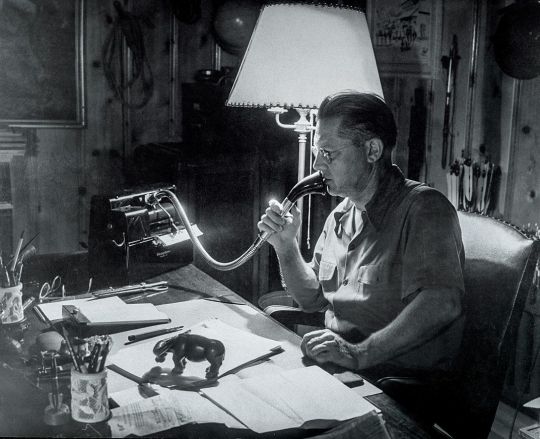
Gardner dictates a story in 1941.
(Bob Landry / The LIFE Images Collection / Getty Images)
What Gardner did understand were the flaws in the prosecution’s case. A bespectacled man with a commanding gaze, Gardner had spent years practicing law in California. In the early 1920s, he’d started writing mystery stories for pulp magazines. He’d published his first Perry Mason novel one month after the murder of Edwards’ wife. Over the years, Perry Mason—a fictional defense attorney who usually defended innocent clients—became the center of a literary juggernaut, generating sales of more than 300 million books as well as a popular TV show.
Like the hero he’d invented, Gardner felt drawn to cases involving the wrongly accused. He believed America’s criminal justice system was often biased against the vulnerable. In the 1940s, Gardner used his fame and wealth to assemble what he called the Court of Last Resort, a group of forensic specialists and investigators who—like today’s Innocence Project at Cardozo School of Law—applied new thinking to old cases.
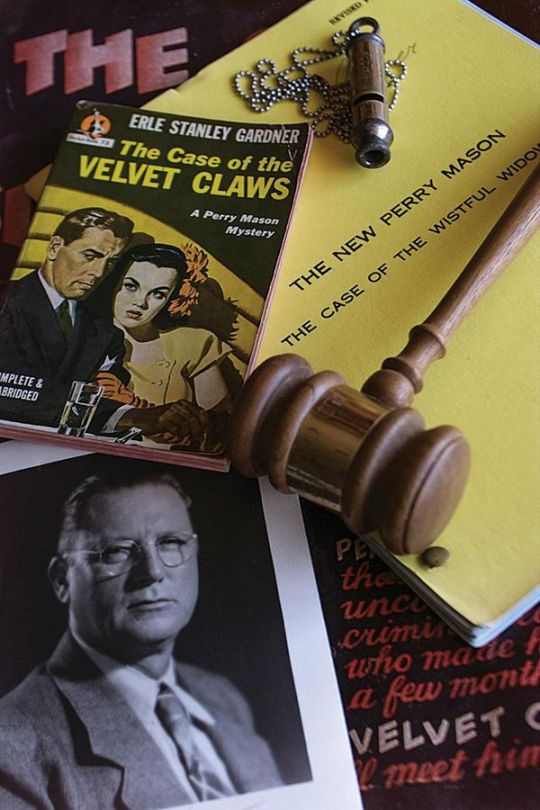
A fan’s collection of Gardner memorabilia. In The Case of the Velvet Claws (1933), the first Perry Mason novel, the character describes himself as “a specialist on getting people out of trouble.”
(Bryan Chan / Los Angeles Times / Getty Images)
Gardner’s team rescued dozens of innocent people from executions and long prison terms. Among them were Silas Rogers, a black man sentenced to death for shooting a police officer in Petersburg, Virginia; Clarence Boogie, a victim of false testimony in a murder case in Spokane, Washington; and Louis Gross, who had been framed for murder in Michigan. Gardner persuaded Harry Steeger of Argosy magazine to regularly publish his articles about his organization’s findings. “We are busybodies,” Gardner declared in a letter to FBI director J. Edgar Hoover. “If, on the other hand, citizens don’t take an active interest in law enforcement and the administration of justice, we are going to lose our battle with crime.”
The letter from the Apache shaman made a strong impression on Gardner. “This Silas John Edwards case has been preying on my mind,” he wrote to James Bennett, the director of the Bureau of Prisons at the U.S. Department of Justice, on May 2, 1952. “This man is a full-blooded Apache Indian. There is every possibility that he didn’t get justice at the hands of a jury who may not have understood Indian psychology, temperament and custom. I think we should investigate the case.”
Gardner met Edwards in prison a few months later, shortly after the Apache shaman had been transferred from McNeil Island to a federal prison camp near Wickenburg, Arizona. The prisoner appeared heavily muscled and younger than his years. “Outwardly he is stoic and calm,” Gardner later recalled. “His alert, attentive eyes miss no detail.” Gardner admired the fact that Edwards had a treasury of Apache tradition and medicinal wisdom stored in his mind. He asked Edwards about the most damning evidence in his case: the rock marked with his initials. “That is no custom to appease the spirit of [the] departed,” Edwards said, “but it is a very fine custom by which somebody can frame a killing on somebody else.”
At the end of their meeting, Edwards dipped his forefinger into a buckskin pouch that hung around his neck. It contained sacred pollen, called hadndin, which Edwards dabbed on Gardner’s forehead in the shape of a cross. He made a similar mark on the crown of Gardner’s hat. (The Holy Ground movement incorporated some elements from Christianity, including the iconography of a cross.) Edwards told Gardner that this ritual would keep him physically and spiritually resilient. “Our medicine was strong,” Gardner concluded after the meeting, reflecting on the new details he���d learned about the case. He agreed to investigate it himself.
* * *
In the fall of 1952, Gardner and another Court of Last Resort investigator, Sam Hicks, arrived at the U.S. District Court building in Tucson to exhume the records from Edwards’ trial. Among the files was a cache of letters that Edwards had written to his lover. In one of them, Edwards recalled a time he and the woman met in a canyon and “the tracks of our feet in the sand were covered by our shadows.” Gardner admitted to feeling some sympathy when he read the letters. He later described the affair in Argosy as a “brief emotional flare-up, a physical attraction for the comely young woman who had such a graceful, streamlined figure.” Edwards insisted that he’d never stopped loving Margaret, that his affection for his wife had “burned with a slow, steady flame that represents the mature companionship of adults who have shared many of life’s vicissitudes.”
The prosecution had asserted that Edwards had grown tired of his wife, found a younger woman who interested him more and murdered Margaret to get her out of the way. But even when Gardner considered the case through that lens, he found the evidence flimsy. “How absurd it is to think that a man would scratch his initials on a rock, leave it at the scene of a murder, and then protest his innocence,” Gardner wrote in Argosy. “One can well imagine how Sherlock Holmes would have curled his upper lip in disgust at the police reasoning that would have thought this rock an indication of guilt.”
Gardner and Hicks drove to Globe, where they met Edwards’ defense lawyer, Daniel Rienhardt, now in his mid-60s, and Robert McGhee, another attorney who had assisted Edwards. Both remembered the Edwards case. (Rienhardt admitted he was a Perry Mason fan and had recently bought a copy of The Case of the Moth-Eaten Mink.)
Together, the lawyers and investigators drove into the mountains north of Globe. They passed through groves of junipers and cedars, crested the high peaks, and descended into the Salt River Canyon. Twisting roads and high bridges brought them to a plateau where the pavement stopped and dirt roads led into the Fort Apache Reservation.

A view from the San Carlos Apache Reservation, one of the areas where Edwards’ religious movement took hold. In recent years, the tribe’s sacred lands have been at the center of a land swap controversy between the U.S. government and a copper mine.
(Ash Ponders)
At the reservation’s police station, Rienhardt asked an Apache officer whether he had ever heard of a custom that compelled a murderer to leave initials near a victim’s body. “In only one case,” the officer replied, “and that happened to be the murder of my mother.” The policeman, Robert Colelay, was Margaret Edwards’ son from an earlier marriage. And he told the investigators that he believed Silas John Edwards did not kill her.
Apache officers escorted the group to the key locations in the case, including the murder site at the edge of the trail. This section of the reservation had not changed much in the years since Margaret’s death. The roads were still rough and many White Mountain tribal members still lived in tepees nearby. Gardner interviewed surviving witnesses and others who had knowledge of the murder. He sketched maps to understand the geography. The visit ended with one of the group’s Apache guides producing a pouch like the one Edwards wore around his neck. He painted crosses in yellow powder on Gardner’s shoulder, forehead and hat.
Nobody Gardner met at the reservation had heard of an Apache tradition involving initials left at a murder scene. One person also challenged the shoe print mold, asserting that a police officer had forced Edwards’ shoe into the original track before the cast was made. “The evidence which convicted him was pathetically inadequate as well as absurd,” Gardner concluded. “The facts strongly indicate an innocent man has been imprisoned.”
Gardner contacted each member of the U.S. Board of Parole to argue for the release of the Apache shaman. Without the inflammatory evidence of Edwards’ adultery, he argued to parole commissioner Joseph Dewitt, “no jury would have returned a verdict of guilty.”
Gardner told the superintendent of the Arizona prison that the Apaches seemed to have “a pretty good general idea” who did murder Margaret. Gardner refused to publish the suspect’s name, but here it can be revealed for the first time in print: He was a White Mountain Apache named Foster James.
The evidence supporting James’ guilt is considerable. One member of the Court of Last Resort, Bob Rhay (who went on to become the longest-serving superintendent of Washington State Penitentiary), spent time looking into it more deeply. “Foster James has admitted on several occasions that he is the actual murderer,” Rhay wrote in a report preserved among Gardner’s papers at the Harry Ransom Center of the University of Texas. He referred to “an affidavit from a Mr. and Mrs. Anderson, in which Mrs. Anderson says that Foster James admitted to her, while he was attacking her, that he had killed Mrs. Edwards.” (Efforts to find surviving friends or relatives of Foster James and include their opinions in this account were unsuccessful. He had no children.)
Kessel, an anthropologist and the grandson of the Lutheran minister who converted Edwards to Christianity, says it was conventional wisdom on the reservation that it was James who had killed Margaret. When Kessel interviewed a number of Apache elders for his academic research on the tribe’s religious movements, they said they believed that Edwards was innocent. Just one interviewee departed from that version of events: Foster James himself.
The tribal chairman had asked Kessel never to mention the accusations against James until after James, Edwards and others close to them died—a promise Kessel would keep. James died in 1976.
For Gardner’s part, he’d noticed that tribal members seemed fearful when they discussed James. “None of these Indians dare to raise their voices above a whisper,” he wrote. “None of them will permit their names to be quoted. The murder of Mrs. Edwards was a ruthless, bloody affair and there is still a silent terror which stalks the Indian reservation.” But more than fear kept the Apaches’ lips closed. In the community of the reservation, with its blood kinships and close relationships, the Apaches did not want to out one of their own.
* * *
On August 1, 1955, Silas John Edwards walked out of prison and returned to reservation life. Though Edwards was already eligible for parole, Gardner’s efforts apparently tipped the scale and persuaded the parole board. Edwards shared the news with Gardner in a letter. According to Gardner, the first thing the newly freed man asked him to do was to thank the readers of Argosy. It’s not known how many of the magazine’s devoted readers wrote to federal officials to protest Edwards’ continuing incarceration, but the response may have been considerable.

A prickly pear cactus on the San Carlos Reservation. “The scenery is really beautiful,” Gardner wrote in an article for Argosy describing his travels through Arizona on Edwards’ behalf. “The desert is not, as so many people think, a barren expanse.”
(Ash Ponders)
Edwards’ followers had kept his movement alive the whole time he was incarcerated, and when he returned to the reservation, he resumed his role as a prophet, albeit with a lower profile. During the 1960s, he led his last Holy Ground snake dance. Soon afterward, he fell back into the more modest role of a traditional medicine man.
Gardner visited Fort Apache again, about a decade after Edwards’ parole. At first, he didn’t recognize the septuagenarian, who was chopping wood: “The man looked even younger than when we had seen him years before in prison.”
Kessel remembers visiting Edwards toward the end of his life, when he was living at an American Indian convalescent home in Laveen, Arizona. “There was no grudge against anybody for anything,” Kessel recalls. “He was a gentleman to the end.” Edwards died in 1977.
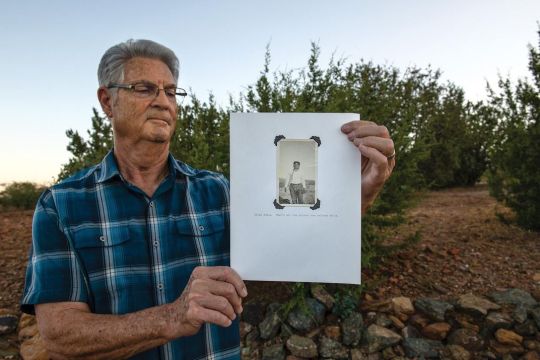
William Kessel, an anthropologist who was born and raised on Apache reservations in Arizona, holds up a portrait of Edwards with a snake around his neck. The photo was taken by Guenther, Kessel’s grandfather, who spent 50 years ministering to Apaches.
(Ash Ponders)
The religious movement he founded has at least one practitioner, Anthony Belvado, who was born on the San Carlos Reservation and makes traditional musical instruments. He carries the same kind of buckskin pouch that Edwards wore around his neck, filled with hadndin, and practices as a healer in the Holy Ground tradition.
Life on Arizona’s reservations is still hard, decades after Edwards’ time. More than 40 percent of White Mountain Apaches live in poverty. Covid-19 has devastated the community—at one point, White Mountain Apaches were being infected at ten times the rate of other Arizonans.
And wrongful convictions remain a problem in Indian country. In 2015, an Alaska judge ordered the release of the “Fairbanks Four,” Indian men who had spent 18 years in prison for a murder they hadn’t committed. A 2016 report from the University of South Dakota found that Indians were dramatically underrepresented on juries, partly because of a cumbersome process that makes it difficult for reservation Indians to register to vote.
Meanwhile, the legacy of Perry Mason lives on. The Supreme Court Justice Sonia Sotomayor has cited the character as an influence, quoting a line spoken by a prosecutor on the show: “Justice is served when a guilty man is convicted and when an innocent man is not.” This past June, 50 years after Gardner’s death, HBO premiered a new Perry Mason television series. For many Americans, the fictional defense lawyer remains a symbol of due process done right.
The Edwards story was “one of the most peculiar murder cases that we have ever investigated,” Gardner said. The invention of a false Indian custom, and the jury’s willingness to believe it, landed an innocent man behind bars for more than 20 years. “If I were writing of this case as a work of fiction,” Gardner told the readers of Argosy, “I would call it The Case of the Autographed Corpse.”
#History
4 notes
·
View notes
Text
Amok killers sentenced to death/executed in the United States (part 8)
So, this should probably wrap up my series.
Perry Edward Smith
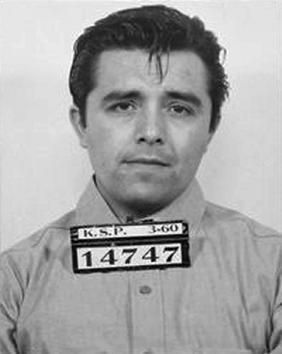
Residence
Holcomb, Kansas
November 15, 1959
4 dead (3 dead by gunfire, 1 was both shot and had his throat cut)
Shotgun, Knife
Sentenced to death. Executed by hanging in 1965. His accomplice, Richard Hickock was also sentenced to death and executed by hanging in 1965.
Roger Dale Stafford

Multiple Locations (including a McDonalds restaurant and a Sirloin Stockade restaurant)
Oklahoma, Alabama, possibly others
1974 - 1978
10+ dead
Firearms
Sentenced to death. Executed by lethal injection in 1995.
Mark Hopkinson
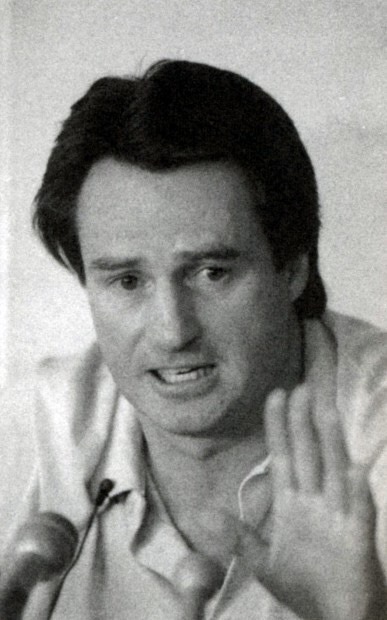
Residence
Evanston and Bridger Valley, Wyoming
1977/1979
4 dead (3 dead in a bombing, 1 dead by gunshot wound to the neck. The victim had also been tortured and his body was found with over 140 burn marks.)
Bomb, Gun
Sentenced to death. Executed by lethal injection in 1992.
Daniel W. "Big Dan" Dowd, Omer W. "Red" Sample, Daniel "York" Kelly, William E. "Billy" Delaney, and James "Tex" Howard
General Store
Bisbee, Arizona
December 8, 1883
4 dead, 1 wounded
Firearms
All 5 men were sentenced to death and executed by hanging in 1884. A 6th conspirator, John Heath, was sentenced to life in prison. Local residents who were dissatisfied with this verdict removed him from his jail cell and lynched him in 1884.
Ricky Javon Gray
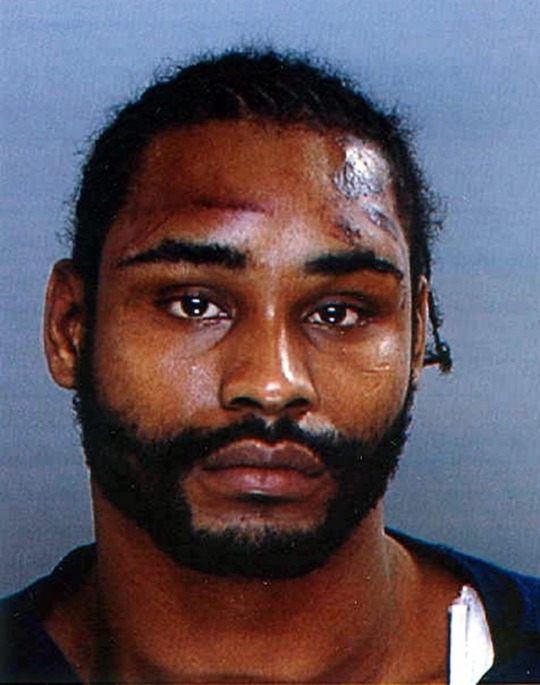
Residences
Richmond, Virginia
January 1/6, 2006
7 dead (2 dead by blunt force trauma to the head inflicted by a claw hammer, 1 had died from a combination of blunt force trauma as well as smoke inhalation from their house that was set on fire, 1 died of a stab wound, and the other 3 died from asphyxiation from having duct tape wrapped around their heads)
Claw Hammer, Knife, Fire, Asphyxiation with Duct Tape/Plastic Bags
Sentenced to death. Executed by lethal injection in 2017.
John Brown
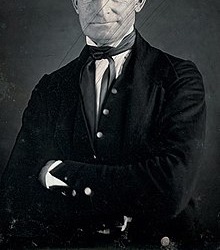
Multiple Locations (Battlefields)
Harpers Ferry, West Virginia; Other Locations
October 16 - 18, 1858 (raid on Harpers Ferry)
5+ dead (including 3 blacks)
Firearms
Sentenced to death. Executed by hanging in 1859.
Note: John Brown was also responsible for several other massacres, as well as inciting slave insurrections in the South. He was hanged for his role in his raid on Harpers Ferry. The Harpers Ferry raid escalated tensions that led to the South's secession a year later and the American Civil War.
1 note
·
View note
Link
Academy Awards 2021: 'Nomadland' wins best picture at an Oscars that spreads the wealth In a year where the pandemic shuttered theaters and turned movie-goers into couch potatoes, 16 of the 23 statuettes went to projects that at the very least simultaneously premiered on streaming services, with “Nomadland,” which was acquired by Hulu, representing the first best picture winner from that relatively new medium. Frances McDormand also won for the film, three years after her Oscar for “Three Billboards Outside Ebbing, Missouri.” Anthony Hopkins, meanwhile, was named best actor for his role as a dementia-ridden man in “The Father,” eclipsing the emotional moment that would have come had Chadwick Boseman been only the third actor to receive posthumous honors for “Ma Rainey’s Black Bottom.” At 83, Hopkins becomes the oldest winner ever. His previous Oscar came almost 30 years ago, for “The Silence of the Lambs.” Unlike some past ceremonies that have seen one film dominate, this year’s awards spread the wealth among multiple movies. “Nomadland” led the way with three awards, while five other films nabbed a pair. Among the producers’ several puzzling choices, best picture was actually presented before the two top acting awards, breaking with years of precedent. Overall, Netflix garnered seven trophies, marking the culmination of the leading streamer’s courtship of Oscar voters, despite resistance and misgivings within the Academy of Motion Picture Arts and Sciences, the organization that presides over the awards. After the nominations made history on a variety of fronts, the awards did as well, Breaking with tradition, the producers chose to hand out best director early, with the Chinese-born Zhao becoming only the second woman ever to claim that prize, following Kathryn Bigelow for “The Hurt Locker” in 2010. “Minari” co-star Yuh-jung Youn also became the first Korean actress to win an Oscar, in the process adding a more dubious footnote to Glenn Close’s illustrious career: With her eighth bid for “Hillbilly Elegy,” she ties Peter O’Toole as the actor with the most nominations without ever having won. Adding to the international flavor, the evening began with screenplay awards that went a pair of Europeans: “Promising Young Woman’s” Emerald Fennell — for a story that dealt with sexual assault — and “The Father’s” Florian Zeller, both of whom also directed those films. (The latter accepted remotely, but most nominees were in Los Angeles.) Daniel Kaluuya earned his first Oscar for “Judas and the Black Messiah,” playing Black Panther Party leader Fred Hampton, in a movie that released simultaneously in theaters and on HBO Max, and also saw H.E.R. earn best song for “Fight For You.” (Both Warner Bros. and the streaming service are, like CNN, a unit of WarnerMedia.) “Soul,” one of the movies redirected to streaming — in this case, Disney+ — was named best animated film, marking the third Pixar movie from director Pete Docter (with Kemp Powers as co-director) so honored, following “Up” and “Inside Out.” It’s also the first of the studio’s movies to feature a predominantly African-American cast, with Jamie Foxx voicing the central character, and added an Oscar for best musical score. “Another Round,” the Danish movie, received the prize for international feature film. Director Thomas Vinterberg delivered an emotional speech about the death of his 19-year-old daughter Ida in a car accident during the making of the film. The makeup/hairstyling team from Netflix’s “Ma Rainey’s Black Bottom” also became the first Black winners in that category, with the Netflix film receiving the Oscar for costume design as well. In other technical categories, “Mank,” the Hollywood history lesson about the making of “Citizen Kane,” took honors for production design and cinematography, “Sound of Metal” claimed sound and editing, and Christopher Nolan’s sci-fi thriller “Tenet” earned best visual effects. Regina King opened the ceremony, referencing the recent verdict in the Derek Chauvin trial, and saying that she wouldn’t apologize for injecting politics into the show. As the mother of a Black son, she said, “I know the fear that so many live with, and no amount of fame or fortune changes that.” Later in the show, the provocative “Two Distant Strangers,” about a police killing of a Black man, was recognized as outstanding short film. Other political issues, such as gun violence, played a role in the ceremony, but one of the most impassioned pleas came from the winner of the Academy of Motion Picture Arts and Sciences’ humanitarian award, Tyler Perry, who urged viewers to join him to “refuse hate” when it came to other people. Due to the pandemic, this year’s Oscars extended the awards calendar by two months and made what was described as a one-time-only exception allowing movies that premiered via streaming and weren’t released theatrically to compete. But those same factors also resulted in several movies that might have contended for awards being delayed beyond the eligibility window, hoping for a more traditional release — and greater box-office revenue — once theaters reopen. As a result, five of the eight best-picture contenders premiered exclusively or simultaneously on streaming services, with Netflix amassing 35 nominations, more than any other distribution entity. Award-show ratings have been in steep decline during the pandemic, and after record-low results for Emmys, Golden Globes and Grammys, the Oscars — which already hit a low point in 2020, when “Parasite” made best-picture history — are expected to be no exception. The focus has been, rather, on putting on the best possible show, and hoping for better in 2022. The pre-show included a video urging people to return to theaters as the movie industry heads into the summer, using the hash tag #TheBigScreenIsBack. Correction: A previous version of this article misstated the number of Oscars Netflix won. It is seven. Source link Orbem News #Academy #Awards #Nomadland #Oscars #picture #Spreads #Wealth #wins
0 notes
Text
Mother of Bathurst bus crash victim still fighting for change nine years after tragedy
January 12 is always a solemn anniversary in New Brunswick, since a bus crash killed seven members of the Bathurst High School basketball team and the coach's wife when their van collided with a transport truck. Since that day, family members, and those who support them, have pushed for change in New Brunwsick.
Isabelle Hains, mother of victim Daniel Hains, passed on nearly 2,000 questions to a crown prosecutor during the 2009 inquest into thetragedy. Families couldn't get standing at the coroner’s inquest, leaving many of their questions unanswered, something that still hasn't changed.
Hain’s group 'Van Angels' has fought for the government to update the New Brunswick Coroners Act, and she still remembers feeling shut out of the Bathurst inquest whenever she sees another family in the same situation.
“I just feel for them, I say, ‘Oh my gosh, if they only knew what they have to go through to get the answers they want,’” says Hains.
“It's unbelievable that we're still dealing with a Coroner's Act that doesn't do so many things for the living and for the dead,” says Van Angels member Melynda Jarratt. “If its aim is to protect the living, I don't think it achieves its goal.”
David O'Brien, a past president of New Brunswick Bar Association, has spent more than a decade pushing for an overhaul of the New Brunswick Coroners Act, fighting to give families and other groups legal standing when it comes to coroner's inquests.
“I think we should take another kick at the can,” says O'Brien.“We're the only jurisdiction in the country that does not permit that. All other jurisdictions have agreed it's a good idea and implemented it, some of them, like Ontario, as long ago as the 1970s.”
Legal standing gives interested parties the right to hire their own lawyers, call witnesses, and ask questions during an inquest.
“It comes from a different perspective if you have members of the family who can ask their own questions rather than having to pass notes to a crown prosecutor,” says O'Brien.
Hains and Jarrett believe acts adopted by other provinces are more effective.
Moncton native Ashley Smith was the subject of an inquiry after her 2007 death in an Ontario jail.
Her family was able to gain legal standing in Ontario and participate in two inquests, which lawyers say was vital in obtaining the eventual verdict of homicide, rather than an accident.
In the years since the Smith inquiry, there are numerous examples of families fighting and failing to obtain legal standing in New Brunswick inquests, from the Serena Perry case in Saint John to the October inquest into the death of Dorchester inmate Glen Edward Wareham.
“2003, 2008, 2009, 2011, and I wrote the last letter in 2013 to whoever was in power in 2013!” says O'Brien. “Liberals, Conservatives, we never really got a principled response as to why they declined to do what's been done everywhere else in the country.”
The Bar Association hasn't requested the Gallant government update the act, but feel change needs to come soon.
The Department of Justice and Public Safety did not respond to CTV's request for comment on Thursday.
With files from CTV Atlantic’s Cami Kepke
from CTV News - Atlantic http://ift.tt/2iN8AQY
0 notes
Text
Erik Malpica Flores Erik Malpica Flores recommends: The CW Teasers: Season Premieres for SUPERNATURAL, THE FLASH, RIVERDALE and More |
What’s coming to The CW the week of October 7? Season premieres! BLACK LIGHTNING, THE FLASH, SUPERNATURAL, RIVERDALE and more all have their season premieres. And the week kicks off with a two-night IHEARTRADIO festival. Finally, the week also features the series premiere of ALL AMERICAN.
Sunday, October 7
The iHeartFestival Music Festival Night 1 (2018)
Monday, October 8
The iHeartFestival Music Festival Night 2 (2018)
Tuesday, October 9
THE FLASH 5.01 “Nora”: After an unexpected guest from the future, Nora West-Allen (Jessica Parker Kennedy), appears at their home, Barry (Grant Gustin) and Iris (Candice Patton,) must figure out how to get her back to the future without disrupting the timeline…even more than she already has. Team Flash must work together to send Nora back, while simultaneously fighting off another villainous meta. David McWhirter directed the episode written by Todd Helbing & Sam Chalsen. (Browse through photos)
BLACK LIGHTNING 2.01 “The Book of Consequences: Chapter One: Rise of the Green Light Babies”: Jefferson Pierce (Cress Williams) and his family may have survived Tobias’s (Marvin Jones III) attack, but they’re not out of the woods yet. Concerned for the safety of Garfield’s students, the board considers a motion to shut down the school, forcing Jefferson to go to Napier Frank (guest star Robert Townsend) to sway the vote. Jennifer (China Anne McClain) struggles with her powers and her actions have unforeseen repercussions. Meanwhile, Anissa (Nafessa Williams) finds a new way to give back to Freeland. Lastly, Lynn (Christine Adams) continues her quest much to the dismay of Agent Odell (guest star Bill Duke). Damon Gupton and James Remar also star. The episode was directed and written by Salim Akil.
Wednesday, October 10
RIVERDALE 3.01 “Chapter Thirty-Six: Labor Day”: As the jury begins deliberations in his murder trial, Archie (KJ Apa) makes a surprising request about how he wants to spend his final days of summer. Betty (Lili Reinhart) is forced to deal with her problems head-on after a heated confrontation with Alice (Madchen Amick) and Polly (guest star Tiera Skovbye) brings up some dark secrets she’s kept hidden. Veronica (Camila Mendes) pleads with Hiram (Mark Consuelos) to step in and help Archie before a verdict is announced. Finally, Jughead (Cole Sprouse) leads the Serpents against the Ghoulies latest attack. Madelaine Petsch, Marisol Nichols, Luke Perry, Ashleigh Murray, Skeet Ulrich, Casey Cott, Charles Melton and Vanessa Morgan also star. Kevin Sullivan directed the episode written by Roberto Aguirre-Sacasa. (Watch a preview and browse through photos)
ALL AMERICAN 1.01 “Pilot”: Spencer James (Daniel Ezra) is a rising high school football player and an A student at South Crenshaw High who is recruited by Beverly High School’s football coach Billy Baker (Taye Diggs). Spencer is conflicted on whether or not to move to Beverly High but Spencer’s mother, Grace (Karimah Westbrook), and his best friend, Coop (Bre-Z), convince Spencer it’s an opportunity he has to seize. When Spencer is forced to move in with Billy and his family, these two families and their vastly different worlds are drawn together. They will discover that the differences that divide us on the surface hide a deeper connection – the complicated, imperfect humanity that unites us all. Also starring Monet Mazur, Greta Onieogou, Samantha Logan, Michael Evans Behling, Cody Christian and Jalyn Hall. The episode was written by April Blair and directed by Rob Hardy. (Watch an extended preview)
Thursday, October 11
SUPERNATURAL 14.01 “Stranger in a Strange Land”: Sam (Jared Padalecki) enlists everyone’s help in trying to track down Dean (Jensen Ackles), who can literally be anywhere. Meanwhile, Castiel (Misha Collins) may be in over his head after meeting up with an unreliable source. After being drained of his grace in season 13, Jack (Alexander Calvert) is adjusting to life as a human, learning new skills and figuring out how he fits in to this world of hunters. Thomas J. Wright directed the episode written by Andrew Dabb. (Watch a preview and browse through photos)
View Source
Ver Fuente
0 notes
Text
Globe, April 6
Cover: Prince Harry and Meghan Markle beg Queen Elizabeth to let them come home because they were wrong

Page 2: Up Front & Personal -- Jennifer Garner, Katy Perry carrying a pillow through an Australian airport, Gerard Butler carries the 2020 Olympic flame to Sparta
Page 3: Joaquin Phoenix steps out barefoot after a Beverly Hills karate class, Corbin Bernsen, Kendall Jenner hops a fence in West Hollywood
Page 4: Ellen DeGeneres is locked in a fierce war with upstart chatterbox Kelly Clarkson who has vowed to unseat the catty comic as TV’s talk show queen bee
Page 5: Wonder Woman hunk Lyle Waggoner took a shocking secret to his grave -- he hated the TV series about the Amazon superhero who made him famous because he resented that his character Gen. Steve Trevor constantly had to be rescued by star Lynda Carter on the original ‘70s series, fans of Modern Family have been clobbered with a double emotional blow -- the hit sitcom has wrapped its final season and the show’s beloved pooch Stella has passed away, David Bowie plunged into a steamy year-long affair with sultry former Harlem madame Laurita Watson and it was OK with then-wife Angela
Page 6: Cover Story -- Desperate Prince Harry and Meghan Markle realize they made a mistake and beg Queen Elizabeth to take them back
Page 8: Coronvirus home remedies and herbs
Page 10: Malia Obama’s fiance Rory Farquharson was caught on camera cuddling another girl and the wedding is off -- the breakup comes as a relief to President Barack Obama who was alarmed over Malia’s nonstop partying
Page 11: With the shooting of his final James Bond film wrapped up Daniel Craig and wife Rachel Weisz are considering baby no. 2 and it’s brought them closer together, a sicko Ariana Grande superfan made it past security on the grounds of her L.A. mansion to bring a love note right to the singer’s door and then spat on the brave cops who came to arrest him
Page 12: Celebrity Buzz -- Jon Voight, Brandi Glanville dated both Matt LeBlanc and David Schimmer before marrying ex-husband Eddie Cibrian in 2001, Hoda Kotb has a problem with perspiration so Today show’s wardrobe wizards are warding off unsightly sweat stains with a water repellent used to keep rain off tents when camping, Steven Weber ate a potent cannabis-infused cupcake at Sarah Silverman’s and ended up high as a kite and possibly had a long conversation with Joaquin Phoenix, Dakota Johnson’s eclectic Hollywood home is a one-of-a-kind showstopper two doors down from Jimmy Kimmel
Page 13: Katie Holmes after a workout class in NYC, Andrew Garfield gets a makeup touch-up on the set of Tick Tick...Boom, Christina Aguilera, Aaron Carter got a facial tattoo with the first name of new girlfriend Melanie Martin
Page 14: Scott Foley is set to headline new Fox pilot The Big Leap, Jesse Tyler Ferguson took art pieces from the set of Modern Family, Fashion Verdict -- Keira Knightley 4/10, Michelle Rodriguez 3/10, Greta Gerwig 1/10, Eiza Gonzalez 9/10
Page 16: On a therapy tape Amber Heard admits she smashed Johnny Depp so hard with a door that she knocked him to the ground and then socking him in the jaw -- Depp’s lawyers played the tape at Amber’s deposition for the $50 million slander suit he filed against her
Page 17: Johnny Depp’s former flames Winona Ryder and Vanessa Paradis have come out swinging in his nasty domestic violence suit against ex Amber Heard
Page 19: 10 Things You Don’t Know About Carey Mulligan, Chrissy Teigen thinks her enhanced boobs have gone bust after motherhood but she fears going under the knife again could kill her, MTV beauty Britt McHenry has confirmed her secret battle with a brain tumor after her condition was leaked
Page 20: True Crime
Page 24: Coronavirus rocks Tinseltown royalty -- Heidi Klum fell ill during a taping of America’s Got Talent sparking fears for her health amid the coronavirus crisis and notorious germophobe Howie Mandel was spotted in a full hazmat suit, after a frightening five days being hospitalized with the coronavirus in Australia Tom Hanks and wife Rita Wilson showed their wacky and serious sides as they completed their quarantine in a rented home, Kelly Ripa made an awkward joke about the virus terror sweeping America by starring in a wacky episode about her serious medical problem -- wrinkles
Page 25: Pandemic panic stuns Today show, frazzled mom-of-five Tori Spelling freaked out when the coronavirus scare caused a run on toilet paper and stores ran out, George Clooney’s tone-deaf sister-in-law Tala Alamuddin is facing serious blowback for hawking fashion face masks that do nothing to protect frightened people from the coronavirus
Page 26: Orlando Bloom swore off sex for 6 months before meeting Katy Perry
Page 36: Health Report
Page 44: Straight Talk -- The Bachelor bosses destroy lives and get rich doing it
Page 45: Al Pacino’s crumbling physical state and deepening mental funk are so alarming his relatives and friends are planning an intervention in a desperate bid to keep him alive, Teresa Giudice has not only dumped her husband Joe Giudice she’s dumping on him by blabbing that he doesn’t turn her on anymore
Page 47: Hollywood Flashback, Bizarre But True
#tabloid#tabloid toc#grain of salt#harry#prince harry#meghan markle#queen elizabeth#coronavirus#malia obama#Michelle Obama#ellen degeneres#kelly clarkson
7 notes
·
View notes
Text
Removing AI Bias From Hiring

“At a recent MIT event on the future of work in New York City for its high-achieving alumni network, Andrew McAfee, co-director of MIT's Initiative on the Digital Economy and a principal research scientist at the university's Sloan School of Management, said leaders are realizing that a lot of their human practices, human resources and human capital practices are simply outdated. McAfee's view: ‘If you want the bias out, get the algorithms in.’ ... [While] algorithms can help HR professionals make smart hiring decisions, ... these algorithms can often be biased against minorities. ... The biases creep in because human bias influenced the algorithm, and it's up to humans to notice the bias and fix it.”
“[C]ompanies reviewing their own code is not enough, especially in the corporate sector, where returns are optimized against near-term revenue, forward investment and stock return, above all else. ‘We know of too many past cases where all a company needed to do is to self-certify, and it was shown to be perpetuating harms to society and, specifically, certain people. ... The public will have little knowledge as to whether or not the firm really is making biased decisions if it's only the firm itself that has access to its decision-making algorithms to test them for discriminatory outcomes’ [said Dr. Frida Polli, pymetrics CEO and co-founder].”
“Suppose there is a situation where bias is found in a third party's algorithm, leading to discrimination in the hiring process, and a corresponding lawsuit follows. ... [I]nstead of having one applicant with a lawsuit, you would have many, because of how much the process has scaled. Companies may try to claim the third party as liable for damages, but that may not hold up in court. ‘If you hire a recruiting company and it has biases [in their algorithm], you're not going to be able to say, 'I'm so sorry, that's the recruiting company's problem.' If you [as the company] hire them to serve as your agent, I believe that you would be on the hook for damages,’ [said Davida Perry, co-founder and managing partner of Schwartz, Perry & Heller LLP].”
CNBC, May 30, 2018: “Silicon Valley is stumped: Even A.I. cannot always remove bias from hiring,” by Eric Rosenbaum
MIT Technology Review, May 25, 2018: “Microsoft is creating an oracle for catching biased AI algorithms,” by Will Knight
The Verdict, May 30, 2018: “AI recruitment: could recruiting ever become fully automated?” by Ellen Daniel
#ai#artificial intelligence#recruitment#bias#automation#technological change#technology#algorithms#algorithmic bias#human resources#discrimination#hr#hiring
0 notes
Text
Jurors deliberate Bill Cosby
NORRISTOWN, Pa. (Reuters) – A Pennsylvania jury of seven men and five women will resume deliberations for a second day on Thursday to decide whether to convict comedian and actor Bill Cosby of sexual assault.
Actor and comedian Bill Cosby leaves court after a day of deliberations in his sexual assault retrial at the Montgomery County Courthouse in Norristown, Pennsylvania, U.S., April 25, 2018. REUTERS/Brendan McDermid
Prosecutors have portrayed the entertainer as a serial predator who hid behind his kindly television persona, while defense lawyers say he has been the victim of women fabricating stories about him in pursuit of wealth and fame.
Cosby, 80, the once-beloved black comedian and TV dad who won over white America on “The Cosby Show” in the 1980s, is on trial on three counts of aggravated indecent assault of Andrea Constand, 45, at his home outside Philadelphia in January 2004.
Cosby has denied the charges, saying any sexual contact was consensual.
The jury, sequestered since the trial began on April 9, was due to begin day two of deliberations at 9 a.m. on Thursday, after a six-hour session on Wednesday, when jurors asked to rehear parts of the case. A previous jury failed to reach a verdict last June, leading to a second trial.
After receiving instructions from Judge Steven O’Neill on Wednesday morning, the jury raised questions three times.
Two hours into deliberations, the jury asked for the legal definition of “consent” in a sexual assault case.
Actor and comedian Bill Cosby leaves court after a day of deliberations in his sexual assault retrial at the Montgomery County Courthouse in Norristown, Pennsylvania, U.S., April 25, 2018. REUTERS/Brendan McDermid
O’Neill said the question could not be answered.
Another question concerned a jury request to see two documents prepared by Jackson outlining her accusations against Constand, which O’Neill denied, and the content of several stipulations about evidence, which he granted.
A third question asked for the rereading of the Cosby deposition and Jackson’s testimony.
Jackson, who was barred from testifying in the first trial, told the court Constand once told her “it would be easy” to fabricate an accusation of sexual assault against a celebrity to make money.
Cosby has remained free on bail. If convicted, he faces up to 10 years in prison for each of the three counts, although sentencing guidelines call for the terms to be served concurrently.
The first trial ended in mistrial last June, just before a flood of sexual assault and harassment accusations against rich and powerful men gave rise to the #MeToo and #TimesUp movements.
Reporting by David DeKok; Writing by Daniel Trotta; Editing by Bill Tarrant and Michael Perry
The post Jurors deliberate Bill Cosby appeared first on World The News.
from World The News https://ift.tt/2vL30JW via Today News
0 notes
Text
Jurors deliberate Bill Cosby
NORRISTOWN, Pa. (Reuters) – A Pennsylvania jury of seven men and five women will resume deliberations for a second day on Thursday to decide whether to convict comedian and actor Bill Cosby of sexual assault.
Actor and comedian Bill Cosby leaves court after a day of deliberations in his sexual assault retrial at the Montgomery County Courthouse in Norristown, Pennsylvania, U.S., April 25, 2018. REUTERS/Brendan McDermid
Prosecutors have portrayed the entertainer as a serial predator who hid behind his kindly television persona, while defense lawyers say he has been the victim of women fabricating stories about him in pursuit of wealth and fame.
Cosby, 80, the once-beloved black comedian and TV dad who won over white America on “The Cosby Show” in the 1980s, is on trial on three counts of aggravated indecent assault of Andrea Constand, 45, at his home outside Philadelphia in January 2004.
Cosby has denied the charges, saying any sexual contact was consensual.
The jury, sequestered since the trial began on April 9, was due to begin day two of deliberations at 9 a.m. on Thursday, after a six-hour session on Wednesday, when jurors asked to rehear parts of the case. A previous jury failed to reach a verdict last June, leading to a second trial.
After receiving instructions from Judge Steven O’Neill on Wednesday morning, the jury raised questions three times.
Two hours into deliberations, the jury asked for the legal definition of “consent” in a sexual assault case.
Actor and comedian Bill Cosby leaves court after a day of deliberations in his sexual assault retrial at the Montgomery County Courthouse in Norristown, Pennsylvania, U.S., April 25, 2018. REUTERS/Brendan McDermid
O’Neill said the question could not be answered.
Another question concerned a jury request to see two documents prepared by Jackson outlining her accusations against Constand, which O’Neill denied, and the content of several stipulations about evidence, which he granted.
A third question asked for the rereading of the Cosby deposition and Jackson’s testimony.
Jackson, who was barred from testifying in the first trial, told the court Constand once told her “it would be easy” to fabricate an accusation of sexual assault against a celebrity to make money.
Cosby has remained free on bail. If convicted, he faces up to 10 years in prison for each of the three counts, although sentencing guidelines call for the terms to be served concurrently.
The first trial ended in mistrial last June, just before a flood of sexual assault and harassment accusations against rich and powerful men gave rise to the #MeToo and #TimesUp movements.
Reporting by David DeKok; Writing by Daniel Trotta; Editing by Bill Tarrant and Michael Perry
The post Jurors deliberate Bill Cosby appeared first on World The News.
from World The News https://ift.tt/2vL30JW via Online News
#World News#Today News#Daily News#Breaking News#News Headline#Entertainment News#Sports news#Sci-Tech
0 notes
Text
Dreadnought by April Daniels

Summary:
An action-packed series-starter perfect for fans of The Heroine Complex and Not Your Sidekick. “I didn’t know how much I needed this brave, thrilling book until it rocked my world. Dreadnought is the superhero adventure we all need right now.”―Charlie Jane Anders, author of All the Birds in the Sky Danny Tozer has a problem: she just inherited the powers of Dreadnought, the world’s greatest superhero. Until Dreadnought fell out of the sky and died right in front of her, Danny was trying to keep people from finding out she’s transgender. But before he expired, Dreadnought passed his mantle to her, and those secondhand superpowers transformed Danny’s body into what she’s always thought it should be. Now there’s no hiding that she’s a girl. It should be the happiest time of her life, but Danny’s first weeks finally living in a body that fits her are more difficult and complicated than she could have imagined. Between her father’s dangerous obsession with “curing” her girlhood, her best friend suddenly acting like he’s entitled to date her, and her fellow superheroes arguing over her place in their ranks, Danny feels like she’s in over her head. She doesn’t have time to adjust. Dreadnought’s murderer―a cyborg named Utopia―still haunts the streets of New Port City, threatening destruction. If Danny can’t sort through the confusion of coming out, master her powers, and stop Utopia in time, humanity faces extinction.
After being really disappointed by Hero by Perry Moore, I finally picked up Dreadnought in the hopes that it would be the LGBTQ+ superhero book I’d been craving. I think there's a lot to be said for the use of secret identities as a parallel to the experience of being in the closet, which makes superhero novels an ideal fit for LGBTQ+ stories. I was also hoping for a book with a good audiobook, because my favorite queer superhero book doesn’t have one.
It was absolutely what I'd hoped for.
As an queer cisgender woman, I related strongly to the ways that Danny experienced people's reactions her new body. It was a lot like what I experienced upon hitting puberty, and I appreciated how honestly that was discussed. The sudden way that her friend turned against her when romance was explicitly off the table was achingly familiar, as was the heteronormativity that colored all her interactions with the people around her (Danny is a lesbian). The little details are spot on—I’m especially fond of the moment when Danny realized that girls holding their books against their chest could also be a way to obscure view of their breasts.
As for the specific transgender issues in this book, some readers might find this one a little anvilicious, to put it in the TVtropes parlance, but sometimes those anvils need to be dropped. A lot of the prejudice faced by Danny in this book was raw and frustrating and real. The way that the people around her reacted—from her father’s desire to put her back in her old body to her mother’s accusation that she is selfish to a TERF superhero who I absolutely hated—was absolutely reflective of the things that my transgender friends have described to me.
And, even with that struggle, it's FUN. Superheroes and supervillains and the struggle between good and evil. The question of what good and evil even ARE. The struggle of having secret identities and trying to find a way to present oneself in public to express who you are. The colored costumes that speak to a hero’s identity. It's all of the things I love about caped crusaders.
Of particular note is the costuming detail, which I’m especially attuned to as a costuming nerd. Superhero costumes are all about the visual rhetoric and communication, and while that can be a struggle to express in text-based storytelling it’s spot on here. Danny’s struggle with whether or not to take on the name and colors of Dreadnought now that she has had that mantle passed on to her is the stuff costuming nerd dreams are made of. We don’t need to see the costume to know she’s struggling with it; adjustments to the color, to whether she wears a mask, and to the technology of her costume are woven throughout the book. Should she become Dreadnought? Should she wear Dreadnought’s colors if she doesn’t take up that name? What face does she want to show the world?
That focus on self-presentation isn’t overtly linked to Danny’s awareness of her gender presentation, but it effectively works as a parallel. It’s discussed in the same self-aware way as painting her toenails, and it creates a strong awareness of self-presentation throughout the book. Danny’s trans identity and the way that people react to it is a huge part of her life, and this parallel allowed the book to take a break from the subject without ever really leaving it behind.
And the plot actually surprised me in a few places! Sometimes superhero narratives can get a little rote and predictable, but I enjoyed every minute of this one. The twists I predicted were still enjoyable, and those that I didn’t (particularly those involving Doc Impossible, my favorite adult character) left me typing in all caps at a friend of mine.
Final Verdict:
Look, I love me some LGBTQ+ superheroes, and this was great. I’m biased toward the subject matter—and it did get quite a boost because I was so disappointed by Hero that it looks a little extra fantastic in contrast—but even so it was a very enjoyable ride and I cannot wait for the sequel. 5/5
0 notes
Text
Globe, June 8
Cover: O.J. Simpson Murder Trial Juror Tracy Kennedy Was Bribed
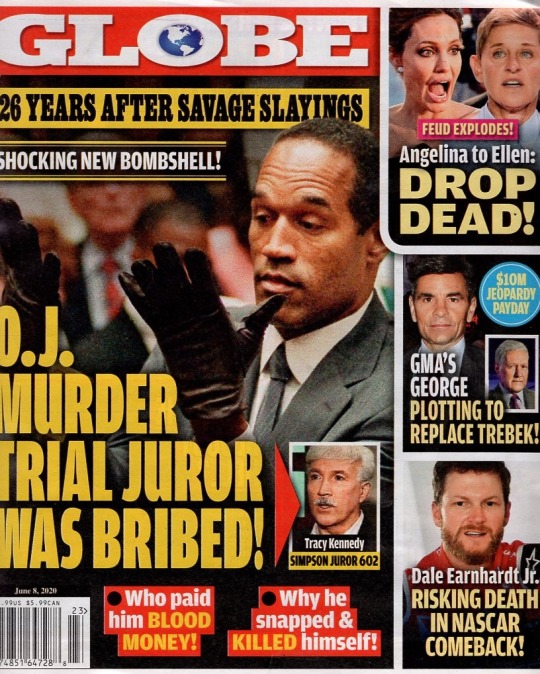
Page 2: Up Front & Personal (to the best of my knowledge none of these photos are from Instagram) Jude Law goes grocery shopping in London, Shia LaBeouf and his dog, Helena Bonham Carter sports an ugly-looking scratch on her face while walking in London
Page 3: Joshua Jackson has flabby man boobs, Golnesa “GG” Gharachedaghi cleans up after her dog in L.A., Linda Perry has her hands full
Page 4: Fed up with being humiliated Caitlyn Jenner has issued a blistering ultimatum to young galpal and fellow sex-swapper Sophia Hutchins: stop bringing your lovers to my home or we’re done, singer Noah Cyrus the little sister of Miley Cyrus says during her childhood she was targeted by trolls who ragged on her looks and made her so sad
Page 5: Ryan Seacrest’s shocking appearance on American Idol has friends fearing the workaholic media mogul is pushing himself into an early grave
Page 6: Meghan Markle is trashing her popular sister-in-law Duchess Kate Middleton with a series of humiliating public insults and behind-the-scenes barbs branding the future queen an uptight backbiting insincere cold fish who refuses to share the limelight
Page 7: Renegade royals Prince Harry and Meghan Markle have gotten another soft deal -- they get 11 years to repay the $2.9 million British taxpayers used to fix up their Frogmore Cottage home in England
Page 8: Valerie Bertinelli was just 19 when she had a hot-and-heavy fling with filmmaker Steven Spielberg who was nearly twice her age
Page 9: Angelina Jolie is cheering the current media mauling of Ellen DeGeneres because it feeds her craving for revenge against the backstabbing talk queen -- Angie has long held a grudge against Ellen for the way she took Jennifer Aniston’s side when Angie first hooked up with Brad Pitt in 2005, Married at First Sight stars Jamie Otis and Doug Hehner changed their minds about their newborn son’s name right after the little guy’s arrival -- the couple welcomed a baby boy May 13 and decided to call him Hendrix instead of their original choice of Hayes
Page 10: Pregnant Katy Perry strips down to her birthday suit and shows off her growing baby bump in her newest music video for Daisies, Lester Holt was horrified to realize he was broadcasting barefoot while working at home even though he was wearing a suit and tie with pants, George Stephanopoulos is plotting to take over Jeopardy! from ailing host Alex Trebek
Page 11: Ian Anderson the 72-year-old singer of Jethro Tull’s epic hit Aqualung says his days are numbered because of a deadly pulmonary condition and thinks on-stage smoke machines are to blame
Page 12: Celebrity Buzz -- Brooke Shields dons a face mask while out in New York City (picture), Robert Pattinson proved he should stay out of the kitchen as his new wacky biz plan for selling fast-food pasta literally went up in smoke, Denise Richards who is married to Aaron Phypers who runs an alternative healing center in Malibu uses a $59 Lovetuner whistle to keep love pitch perfect and she finds it calming and grounding -- she also scatters $110 grounding bags filled with pink crystals believing they help repel EMF frequencies from cellphones and computers, Rosie O’Donnell who is quarantining at a $6 million weekend estate in New Jersey’s she’s been trying to unload admits she’s bingeing on sweet treats at an alarming rate, Reese Witherspoon asked co-star and pal Laura Dern to reenact ‘80s soap Dynasty with her as a birthday present
Page 13: Newlywed Chandler Powell shops for flowers (picture), Jamie Lee Curtis goes barefoot for a stroll outside her L.A. home (picture), Jussie Smollett out and about in L.A. (picture), it’s no horror being likened to now-svelte stunner Adele according to her look-alike Sarah Paulson but she wishes she was as talented as Adele
Page 14: Bored Hollywood celebs have been offering their own road-rageous accounts of star sightings -- Jane Lynch almost ran over Diane Keaton and Kevin McHale says Roseanne Barr almost ran him over when he was a child and Loni Love claims she watched Samuel L. Jackson get hit by a car, Joshua Jackson’s wife Jodie Turner-Smith had postpartum acne after their baby daughter was born in April so she put breast milk on them and her skin looked much better, Fashion Verdict -- Emily Blunt 9/10, Suki Waterhouse 2/10, Lourdes Leon 3/10, Kristin Scott Thomas 1/10, Claire Danes 8/10
Page 16: True Crime
Page 19: 10 Things You Don’t Know About Savannah Guthrie, Kurt Cobain’s daughter Frances Bean Cobain and widow Courtney Love have apparently lost their ferocious battle over Kurt’s famed guitar, Judi Dench has hit the highest levels of her profession including winning an Oscar but she has one huge regret: not doing enough love scenes
Page 20: Alicia Keys’ father abandoned her and her mother when she was just 2 and she’s shared a heartbreaking divorce paper she sent him at 14, Cynthia Bailey of RHOA has likened lockdown love to sex in the slammer
Page 22: Johnny Depp scored a big win in his court fight with ex-wife Amber Heard when a judge allowed evidence the actress forged their dogs’ medical documents and guzzled wine and also admitted former lovers’ testimony that Johnny was never violent, Joan Collins became notorious for her nude scenes in the 1978 film The Stud but she insists the action was tame compared to Hollywood’s current offerings

Page 23: Funny Photo Quiz -- Alex Winter and Keanu Reeves in the new Bill and Ted movie
Page 24: Cover Story -- Juror took bribe during the O.J. Simpson murder trial -- Juror No. 602 Tracy Kennedy was booted from the panel after just nine weeks for taking money to write a book about the trial of the century in 1995 but in a chilling twist Kennedy and his wife Judith were found shot dead lying next to each other with two handguns nearby in 2008
Page 26: Health Report -- your nonstick pans could be harming you, zap your migraines with yoga
Page 29: Racing legend Dale Earnhardt Jr. is speeding toward a NASCAR comeback but insiders fear his history of head injuries may mean he’s risking his life and endangering his fellow drivers, Kendall Jenner has revealed a lifetime of massive panic attacks
Page 30: For fear of his father’s contracting coronavirus Jack Osbourne is monitoring dad Ozzy Osbourne’s diet, Daniel Craig’s final outing as James Bond is the franchise’s most expensive -- No Time to Die cost a whopping $242 million to shoot
Page 32: Rival talent show judges Christina Aguilera and Jennifer Lopez’s racy battle of the boobs has triggered a backlash from fans and plopped them in hot water with government bigwigs -- the divas strutted their stuff to grab watchers and ratings with Christina on The Voice and J.Lo on American Idol so much in the 2015-16 seasons that shocked viewers wrote complaints to the Federal Communications Commission (FCC) which can boot a show off the air for obscene content, Jennifer Lopez and Alex Rodriguez’s arrogant airs and ravenous publicity grabbing has led them to lose friends fast -- they give off the impression that nobody is really in their league and it’s backfired in a big way and left them feeling socially isolated
Page 38: Real Life
Page 44: Straight Talk -- Kylie Jenner is no nip/tuck novice
Page 45: Ben Stiller said his ailing father Jerry Stiller was dealing with a lot of issues but he died peacefully and with a sense of humor, Fred Willard went to his grave haunted and humiliated by an X-rated sex bust in 2012 when cops claimed they caught him with his pants down at the sleazy Tiki Theater in Hollywood but he was so deeply in love with his wife Mary that he was devastated she had to suffer through that embarrassment
Page 47: Hollywood Flashback -- Porky’s, Bizarre But True
#tabloid#tabloid toc#grain of salt#o.j. simpson#tracy kennedy#robert pattinson#rob pattinson#johnny depp#justice for johnny depp#johnny depp is innocent#johnny depp is a victim#amber heard#caitlyn jenner#sophia hutchins#ryan seacrest#meghan markle#prince harry#kate middleton#duchess kate#valerie bertinelli#steven spielberg#angelina jolie#ellen degeneres#brad pitt#jennifer aniston#katy perry#lester holt#george stephanopoulos#jeopardy!#alex trebek
6 notes
·
View notes
Text
Globe, February 4
Cover: Prince Charles Tells Prince Harry -- Meghan Markle Must Go

Page 2: Up Front & Personal -- Courteney Cox, Jodie Foster, Joey Fatone
Page 3: Hugh Jackman, Rihanna, Val Kilmer
Page 4: Aretha Franklin’s kids scramble for chunk of $80M pie as cops probe missing cash
Page 6: Cover Story -- Royal family demands that Meghan Markle must go, Prince Harry threatening to renounce his royal duties to stand by his pregnant wife
Page 8: ISIS plants poison at Kate Middleton’s grocery store aimed at killing her kids, Michael J. Fox gets his first tattoo at age 57, Whoopi Goldberg hosting a wedding for her granddog
Page 10: Russell Crowe confesses he loves Terri Irwin
Page 12: Celebrity Buzz -- Daniel Craig and Rachel Weisz have hooked up Halle Berry and Keanu Reeves, lonely Brad Pitt pours his heart out every night to a tape recorder, Joanna Gaines is driving husband Chip crazy with her latest cleaning spree, Elvis’ granddaughter Riley Keough admits to having anxiety and depression, bloated Ben Affleck is a broken wreck, Billy Dee Williams
Page 13: Luke Perry, Catherine Bach, Natalie Portman, Hook-Ups, Babies & More
Page 14: Roseanne Barr claims she was fired due to anti-Semitism, the bickering between Tyrese Gibson and ex Norma Gibson has gotten so bad that a judge had to decide whether their 11-year-old daughter could play soccer, Fashion Verdict -- Brie Larson, Glenn Close, Judith Light, Miranda Kerr, Bella Hadid
Page 16: Jennifer Aniston adopting a baby girl from Mexico orphanage, the actresses who played Rachel and Ross’ daughter Emma twins Noelle and Cami Sheldon are now 16
Page 18: 10 Things You Don’t Know About Eric McCormack, Martha Stewart shared her secret to making perfectly fluffy scrambled eggs using a milk frother on an pricey espresso machine and was slammed for being out of touch with everyday Americans, skinny Kelly Ripa whines she looks like Peter Pan no matter what she does
Page 20: True Crime
Page 24: Raging Al Roker unloaded on Jillian Michaels after she slammed the trendy keto diet and now her comments could see her iced out of NBC for good
Page 25: Steve Harvey hates Kelly Clarkson after she stole his NBC talk show time slot
Page 28: Hollywood Legends -- Glenn Miller death plane found, Humphrey Bogart lost it over leeches while filming The African Queen
Page 30: Health Report -- new injection ends back pain for keeps
Page 32: Drew Barrymore swears she’ll never do heroin of get plastic surgery because of her addictive personality, John C. Reilly wore an air-conditioned fat suit to play corpulent comic Oliver Hardy in the film Stan & Ollie
Page 34: Straight Talk -- time to cut off sex creep’s R. Kelly’s cash, Spot the Evil Twin -- Seth Meyers and Hugh Grant
Page 38: Real Life -- UFO caught on camera, space station astronaut accidentally calls 911
Page 41: Money-hungry mistress Lauren Sanchez chased Jeff Bezos from day 1, pregnant Jessica Simpson is in agony with super swollen feet, Harry Potter actress Miriam Margolyes who played Professor Sprout confesses she hates kids
Page 45: Fears for Celine Dion after backstage collapse
Page 47: Hollywood Flashback -- Natalie Wood and James Dean of Rebel Without a Cause

#tabloid#gossip#Prince Charles#Duchess Meghan#meghan markle#natalie wood#james dean#rebel without a cause
2 notes
·
View notes
Link
Transformed by Covid and Industry Shifts, the 2021 Academy Awards Sets Off LOS ANGELES — A surreal 93rd Academy Awards, a stage show broadcast on television about films mostly distributed on the internet, got underway on Sunday with Regina King, a former Oscar winner and the director of “One Night in Miami,” strutting into a supper-club set. “It has been quite a year, and we are still smack dab in the middle of it,” she said, referencing the pandemic and the guilty verdict in the George Floyd murder trial. “Our love of movies helped to get us through.” With little more preamble, Oscar statuettes were handed out, with Emerald Fennell, a first-time nominee, winning best original screenplay for “Promising Young Woman,” a startling revenge drama. The last woman to win solo in the category had been Diablo Cody (“Juno”) in 2007. “He’s so heavy and so cold,” Fennell said about the gold-plated Oscar statuette in an impromptu speech that revisited one she wrote when she was 10 and loved Zack Morris in the television series “Saved By the Bell.” “They said write a speech. I’m going to be in trouble with Steven Soderbergh,” she said. Christopher Hampton and Florian Zeller won the adapted screenplay prize for “The Father,” about the ravages of dementia. “Another Round,” about middle-age men who decide to get drunk daily, won the Academy Award for international feature film (previously referred to as foreign-language film). The Danish filmmaker Thomas Vinterberg dedicated “Another Round” to his daughter, Ida, who was killed in a car crash in 2019. “Maybe you’ve been pulling some strings somewhere,” Vinterberg said, fighting back tears. Going into the ceremony, there was a chance that the night could go down in Hollywood history. People of color were nominated for all four acting awards — an indication that the film industry has implemented meaningful reforms. The academy, which has roughly 10,000 members, remains overwhelmingly white and male, but the organization has invited more women and people of color into its ranks following the intense #OscarsSoWhite outcries in 2015 and 2016, when the acting nominees were all white. This year, nine of the 20 acting nominations went to people of color. As expected, Daniel Kaluuya was named supporting actor for playing the Black Panther leader Fred Hampton in “Judas and the Black Messiah.” “Bro, we out here!” Kaluuya shouted in celebration before growing serious and crediting Hampton (“what a man, what a man”) and ending with the cri de coeur, “When they played divide and conquer, we say unite and ascend.” Hollywood wanted the producers of the telecast to pull off an almost-impossible hat trick. First and foremost, they were asked to design a show that prevented the TV ratings from plunging to an alarming low — while celebrating movies that, for the most part, have not connected widely with audiences. The producing team, which included the Oscar-winning filmmaker Steven Soderbergh (“Traffic”), also hope to use the telecast to jump-start theatergoing, no small task when most of the world has been out of the box office habit for more than a year. Lastly, the producers needed to integrate live camera feeds from more than 20 locations to comply with coronavirus safety restrictions. The Academy of Motion Picture Arts and Sciences had delayed the event, which typically takes place in February, in hopes of outrunning the pandemic. Still, the red carpet had to be radically downsized and the extravagant parties canceled. Updated April 25, 2021, 9:03 p.m. ET For the first time, the academy nominated two women for best director, recognizing Chloé Zhao for “Nomadland,” a bittersweet meditation on grief and the American dream, and Fennell for “Promising Young Woman,” about the aftermath of a sexual assault. The other nominated directors were David Fincher for “Mank,” a black-and-white love letter to Old Hollywood; Lee Isaac Chung for “Minari,” a semi-autobiographical tale about a Korean-American family; and, in a surprise, Vinterberg for “Another Round.” Zhao had already been feted for her “Nomadland” direction by nearly 60 other organizations, including the Directors Guild of America and the British Academy of Film and Television Arts. In 93 years of the Academy Awards, only one woman, Kathryn Bigelow, has ever won. (Bigelow was celebrated in 2010 for directing “The Hurt Locker.”) The directing category has also been dominated over the decades by white men, giving the nomination of Zhao, who is Chinese, even greater meaning. Netflix was back in the best picture race. Netflix received its first Oscar nomination in 2014 for “The Square,” a feature documentary about the Egyptian revolution. Since then — in large part because of copious amounts of money spent on awards campaigns — the streaming giant has come to dominate the nominations. It amassed 36 this year, more than any other company, with “Mank” receiving 10, more than any other film. But Netflix and its sharp-elbowed awards campaigners keep whiffing in the end. Last year, the company’s best-picture hopes rested on “The Irishman.” It failed to convert even one of its 10 nominations into a win. In 2019, Netflix pushed “Roma.” It won three Oscars, including one for Alfonso Cuarón’s direction, but lost the big prize. On Sunday, Netflix had two nominees, “Mank” and “The Trial of the Chicago 7.” Those films were competing against Zhao’s “Nomadland,” an entry from Searchlight, a division of the Walt Disney Company. The other nominees for best picture were “Sound of Metal,” “Minari,” “Promising Young Woman,” “Judas and the Black Messiah” and “The Father.” There was nothing usual about the broadcast. Soderbergh was not your usual Oscar producer, which is why he may have been the perfect choice for this very unusual year. He and his producing partners for the event, Stacey Sher and Jesse Collins, eschewed Zoom and implemented enough protocols to enable a mask-free environment for the nominees. In the lead-up to Sunday, Soderbergh kept referring to the show as a three-act film. The telecast’s writing staff included the “Surviving R. Kelly” filmmaker Dream Hampton and the veteran writer-director Richard LaGravenese (“The Fisher King”). Presenters were referred to as “cast members.” They included Zendaya, Brad Pitt and Bong Joon Ho, last year’s winner for best director. The ceremony has typically included performances of the five tunes nominated for best song. Not this year. Those were moved off the main stage and onto a preshow, which allowed them to be performed in their entirety. This year, however, the academy decided to hand out two honorary Oscars during the primary show. (Since 2009, honorary statuettes have been awarded during a nontelevised banquet in the fall.) The nonprofit Motion Picture & Television Fund, which underwrites a nursing home and retirement village for aging and ailing “industry” people (actors, executives, choreographers, lighting technicians, camera operators), received one. The organization, founded in 1921 by stars like Mary Pickford and Charlie Chaplin, also provides a wide range of other services to Hollywood seniors. The second went to Tyler Perry, who the academy cited as a “cultural influence extending far beyond his work as a filmmaker.” Perry, of course, started his entertainment career as a playwright. Since ending his popular, nine-film “Madea” series in 2019, Perry has focused on making television shows like “Bruh,” “Sistahs” and “The Oval” for BET. He owns a studio in Atlanta. The Dolby Theater, which holds more than 3,000 people and has been the home of the Academy Awards since 2001, was not the epicenter of the telecast. This year, with just the nominees and their guests in attendance, an Art Deco, Mission Revival train station in downtown Los Angeles served as the main venue. Source link Orbem News #Academy #Awards #Covid #Industry #sets #Shifts #transformed
0 notes